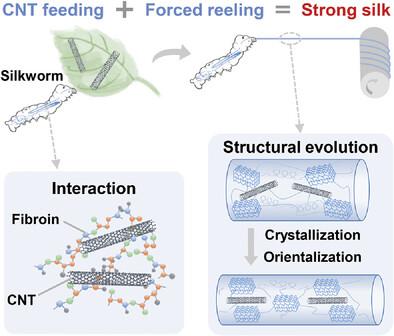Strong Silkworm Silk Fibers through CNT-Feeding and Forced Reeling
IF 27.4
1区 材料科学
Q1 CHEMISTRY, MULTIDISCIPLINARY
引用次数: 0
Abstract
High-performance silk fibers, with their eco-friendly degradability and renewability, have long captivated researchers as an alternative to synthetic fibers. Spider dragline silk, renowned for its exceptional strength (>1 GPa), has an extremely low yield, hindering its widespread use. While domesticated silkworms (Bombyx mori) can produce silk fibers industrially, their moderate strength (≈0.5 GPa) pales in comparison to the formidable spider dragline silk. In this study, naturally produced strong silkworm silk fibers are reported with a tensile strength of ≈1.2 GPa achieved through combining feeding carbon nanotubes (CNTs) to silkworms and in situ forced reeling for alignment. Molecular dynamics simulations confirm the interaction between the CNTs and silk fibroin, while the forced reeling process aligns these reinforcing fillers and the silk fibroin β-sheet nanocrystals along the fiber axis. Structural analysis reveals a significant enhancement in the content and alignment of β-sheet nanocrystals within the silk fibers, accounting for their superior mechanical properties, including tensile strength of ≈1.2 GPa and Young's modulus of 24.4 GPa, surpassing various types of silkworm silk and spider silk. This advancement addresses the historical trade-off between the strength and scalability of silk, potentially paving the way for eco-friendly, biodegradable, and renewable alternatives to synthetic fibers in a variety of applications.

通过 CNT 育丝和强制缫丝获得强韧的蚕丝纤维
高性能蚕丝纤维具有生态友好的降解性和可再生性,作为合成纤维的替代品长期以来一直吸引着研究人员的目光。蜘蛛拖丝以其超高强度(1 GPa)而闻名,但产量极低,阻碍了其广泛应用。虽然驯养的蚕(Bombyx mori)可以工业化生产丝纤维,但其强度适中(≈0.5 GPa),与强大的蜘蛛拖丝相比相形见绌。在这项研究中,通过给蚕喂食碳纳米管(CNTs)和原位强制缫丝对齐相结合的方法,报告了天然生产的强韧蚕丝纤维,其抗拉强度≈1.2 GPa。分子动力学模拟证实了碳纳米管和蚕丝纤维素之间的相互作用,而强制卷绕过程则使这些增强填料和蚕丝纤维素β片纳米晶体沿纤维轴线排列。结构分析表明,蚕丝纤维中β片纳米晶体的含量和排列有了显著提高,因此具有卓越的机械性能,包括拉伸强度≈1.2 GPa,杨氏模量24.4 GPa,超过了各种类型的蚕丝和蜘蛛丝。这一进步解决了蚕丝在强度和可扩展性之间的历史权衡问题,有可能为在各种应用中以生态友好、可生物降解和可再生的方式替代合成纤维铺平道路。
本文章由计算机程序翻译,如有差异,请以英文原文为准。
求助全文
约1分钟内获得全文
求助全文
来源期刊

Advanced Materials
工程技术-材料科学:综合
CiteScore
43.00
自引率
4.10%
发文量
2182
审稿时长
2 months
期刊介绍:
Advanced Materials, one of the world's most prestigious journals and the foundation of the Advanced portfolio, is the home of choice for best-in-class materials science for more than 30 years. Following this fast-growing and interdisciplinary field, we are considering and publishing the most important discoveries on any and all materials from materials scientists, chemists, physicists, engineers as well as health and life scientists and bringing you the latest results and trends in modern materials-related research every week.
 求助内容:
求助内容: 应助结果提醒方式:
应助结果提醒方式:


